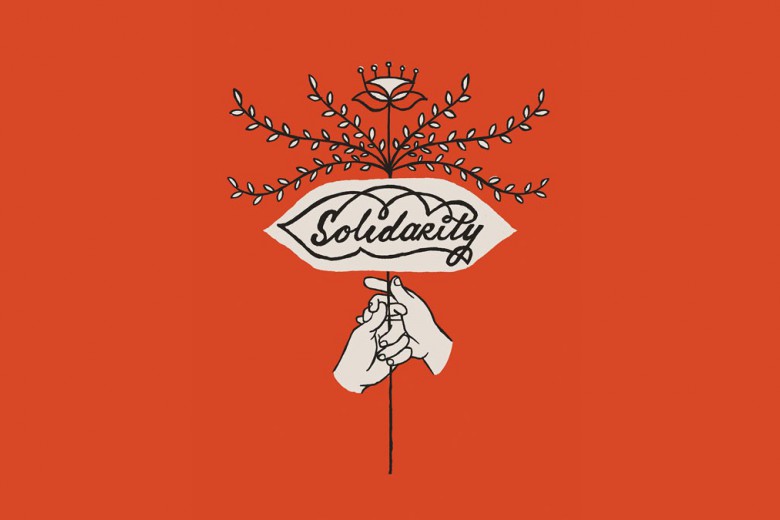
Illustration: Melanie Cervantes
In 1919, the body of a Jewish Polish woman was pulled from Berlin’s Landwehr Canal, a bullet hole in her skull. Who today knows that it was Germany’s social democratic leadership who had opposed Rosa Luxemburg’s radical internationalism and collaborated with the right-wing militia that put her to death?
Many on the left see Rosa Luxemburg as a hero, but only a few draw theoretical or strategic inspirations from her work. Her disregard for party bureaucracies offended social democrats and communists. Feminists find her too Marxist, and Marxists charge her with misunderstanding Marx’s Capital.
On the other hand, her works, notably The Accumulation of Capital, first published 100 years ago, read as if they were written against the background of today’s IMF structural adjustment programs, privatization of public services, and capitalist penetration of moral economies, bodies, and nature. While many celebrate her revolutionary life, fewer appreciate what her analysis of 19th-century capitalism and imperialism can contribute to an understanding of our own times. Luxemburg’s thinking about socialist politics, which is firmly embedded in her economic analysis, offers key ideas and insights for leftist strategy today.
Accumulation of capital
For capitalism, the whole world is for sale. Luxemburg shows that the combined spending of capitalists and workers will never be enough to buy everything the latter produce under the former’s control. Most workers would probably spend more if their wages were higher, but wage increases in the shortrun lead to the implementation of labour-saving technology, layoffs, and a lowering of total wage payments in the longrun.
Capitalists certainly could spend more on investment, but ultimately this would lead to additional production capacity that would only be profitable if consumer demand also increases. Investing in machines, buildings, and infrastructure for the sake of producing more machines, buildings, and infrastructure may work for a while, but it won’t work forever. At some point, capitalists won’t be able to sell more machines to each other if existing production capacity already satisfies consumer demand. Capitalism is caught between a profit squeeze, caused by rising wages, and underconsumption, induced by labour-saving technologies and a disproportionate buildup of production capacity. The only way out is selling even more stuff by entering non-capitalist milieus.
Rosa Luxemburg recognized that capitalist accumulation requires colonizing and commodifying all human activity and nature. However, the more that capitalist expansion proceeds, the harder it is to find non-capitalist milieus. If the whole world would really be for sale, capitalism would suffer from insufficient demand and economic stagnation.
According to Luxemburg, this would lead to increasingly sharp conflicts between capitalists and workers. Only a transition to socialism, which does not rely on endless accumulation, could avoid unending distributional conflict and the political and social decline that comes with it.
This, in a nutshell, is the conclusion Luxemburg drew from her analysis of 19th-century capitalism and imperialism. She developed her arguments against the background of the consecutive industrializations of England, Germany, and Russia, and the complementary colonization of Asia and Africa.
Although the political forms of capitalist expansion have changed a lot since her day, especially with the transition from colonial empires to imperialism without colonies, its economic content hasn’t changed. The mad thirst for cheap labour, natural resources, and new customers drives capitalists around the world today, just as it did in Rosa Luxemburg’s day.
What is important to understand, though, is that capitalist penetration of non-capitalist milieus is not just about geographical expansion. As Luxemburg pointed out, while imperialist competition stiffened abroad, plenty of untapped non-capitalist milieus continued to exist in the imperial heartlands.
There were peasants, shopkeepers, or artisans who sold their products for money but didn’t earn a surplus above their consumption to invest. Alongside this sector of simple commodity production, to use Marxist terminology, plenty of work was done in private households. Households consumed goods and services bought for money, but were also productive in ways separate from the circuits of capital accumulation. And, of course, households were and are the origin of all human labour.
Heartlands and ex-colonies
Non-capitalist milieus in the imperial heartlands were only penetrated by capitalism after imperialist competition and the accumulation strategies that accompanied them led to a series of world wars, revolutions, and counter-revolutions between the 1910s and the 1940s. Ironically, it was the integration of working classes into welfare capitalism from the 1950s to the 1960s that led to the replacement of artisan, peasant, and household production by mass-produced commodities. This colonization of households – or, in Marxist-feminist parlance, the sphere of reproduction – boosted capitalist accumulation and thus contributed to rising wages.
Yet mass consumption by households required more than rising wages; it required additional family income. Women who entered the workforce in increasing numbers rightly demanded an end to gender discrimination while workers of different kinds began resisting speed-ups, the increasingly mind-numbing character of standardized work, and management control. Women’s and workers’ movements in the 1970s – sometimes together, sometimes independently of each other – represented the limits of further capitalist expansion and thus contributed to capitalist crisis.
The crisis was further aggravated by the radicalization of anti-colonial movements. Faced with the challenge of the Russian and Chinese revolutions, in 1917 and 1949 respectively, imperial powers encouraged the transformation of former colonies and suppliers of agricultural products and natural resources into developmental states that could be industrialized and then enter a phase of mass consumption. Since the promises of independence associated with the industrialization process exceeded the ability to deliver in most postcolonial countries, anti-imperialist and anti-capitalist movements emerged, most famously in Cuba and Vietnam.
The rollback
Welfare states in the North and developmental states in the South were halfway houses between capitalism and socialism: whatever they had accomplished was dependent on capitalist accumulation and ongoing Indigenous dispossession. When the postwar boom went bust in the 1970s, they were confronted with fiscal and sovereign debt crises, respectively.
In the 1970s, mass consumer markets were saturated and southern industrialization contributed to global overcapacity. The globalization of Western norms of consumption might have been possible, but capitalists feared this would lead to a profit squeeze. A wave of militant labour struggles, the emergence of new social movements, and the radicalization of the anti-colonial revolution had already sounded alarm bells and caused the turn from the Keynesian class compromise to neoliberal class struggle from above.
Nostalgia for the Keynesian welfare state, popular in some social democratic circles these days, ignores that the economic prosperity and capitalist willingness to make concessions to organized labour were unique conditions of the postwar period that are gone for good.
Luxemburg argued that international loans were one of the ways to draw non-capitalist milieus into the orbit of capital accumulation, and this is exactly what has happened since the 1980s through the IMF, World Bank, and “structural adjustment.” Developmental regimes have been forced to turn subsistence farming into cash crop production and reorient industries from domestic to foreign markets. In doing so, they have helped capitalism move production from the old industrial centres, where workers had gained some strength through their unions and the welfare state, to newly industrializing countries and export-processing zones in the South.
When the Soviet Union collapsed under the weight of bureaucratic, authoritarian rule and the Chinese communists turned onto the capitalist road, huge new areas became available for capitalist penetration. However, since the Great Recession of 2008-09, a new era of insufficient demand and stagnation – a “global slump” – has begun. Capitalism has to find new markets or once again face continued economic decline, international conflict, and intensified class struggles.
Critics often charge Luxemburg with expecting spontaneous working-class rebellion and revolution to automatically result from economic crises. Careful reading of her work suggests otherwise. Her discussion of socialist strategy in Social Reform or Revolution and The Mass Strike, the Political Party, and Trade Unions shows that she understands working-class formation as a collective learning process. Understanding that wage increases and social reforms that workers win during economically good times will come under pressure from capitalists in bad times, like now, she sees the value of the struggles for such reforms to be more in the experiences workers have and less in the material gains they make.
The power to overcome capitalist rule is built on such experiences. It is also built on workers’ self-organization. Looking at trade unions, social democratic parties, and even the revolutionary Bolsheviks, Luxemburg warned that bureaucratization was a force that could undermine such self-organization. She made it very clear that social democratic bureaucracies weren’t capable of taming capitalism but also that capitalism couldn’t be overcome by Bolshevik vanguards alone or by spontaneous rebellion without political organization. Instead, she tried to contribute to the development of collective capacities of the working class.
Workers of the world again?
The integration of working classes in 20th-century welfare states, and to a lesser extent developmental states, confirmed Luxemburg’s views. During the postwar boom, workers made some headway, but, due to the institutionalization of workers’ organization during that time, they were unprepared to fight against the capitalist offensive that started after the economic crises in the 1970s.
Autonomous workers’ and women’s movements that entered the scene at the same time didn’t suffer from bureaucratization.
Activists who were involved in them were able to create the kind of experiences Luxemburg considered crucial for the building of collective capacities. Yet the workplaces in which these activists had their basis soon fell prey to capitalist restructuring, and some of the autonomous movements purposefully steered away from class politics, identifying it with union and party bureaucrats.
Thirty years of restructuring later, the role of these bureaucrats has been largely demolished, and the working classes that were the basis of party and union bureaucracies have been taken apart. The reorganization of firms and labour processes, along with offshoring and labour-saving technologies, unmade the working classes that had developed in the West. Ironically, though, the same restructuring also laid the groundwork for making new working classes around the world. The strict division between industrial workers in the North and peasants in the South that Luxemburg and her contemporaries witnessed is gone.
A higher share of the world’s population than ever before depends on the sale of their labour power. These workers of the world are highly diverse. And while discontent with today’s capitalism pops up everywhere, we are still in the early stages of new working-class formations and the development of a new socialist project. Reading Rosa Luxemburg today offers theoretical tools to guide radical politics for the future.



_780_520_s_c1_c_t.png)


